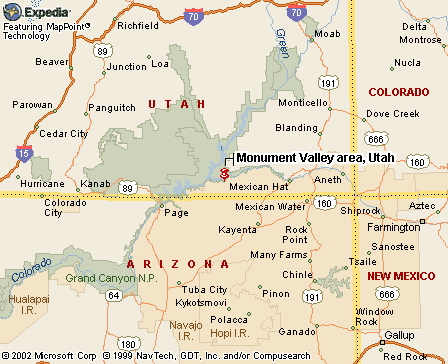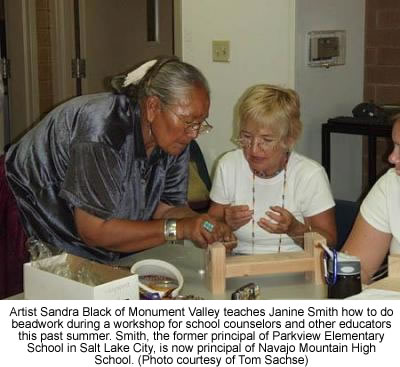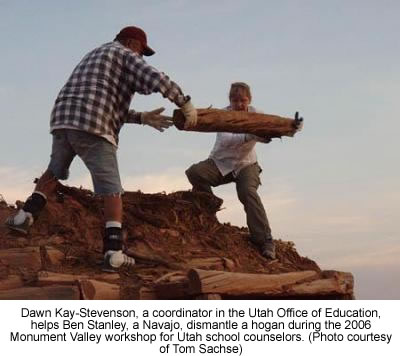 |
Canku Ota
|
 |
|
(Many Paths)
|
||
|
An Online Newsletter
Celebrating Native America
|
||
|
November 1, 2008 - Volume
6 Number 2
|
||
|
|
||
|
Living with Navajo
is a lesson in understanding
|
||
|
by Kristen Moulton -
The Salt Lake Tribune
|
||
|
To
empathize with students, educators spend a week in Monument Valley
cooking fry bread and shoveling manure
A
group of educators is trying to change that. Since
2004, the group has taken about 30 educators, most of them school
counselors, to Monument Valley for a week to live among the Navajo,
including side trips to visit White Mesa Utes and the Hopis in northern
Arizona. "We
thought we had a good idea, but after our first year, we knew we
had a really good idea," said Janet Canyon, coordinator for
Title VII programs in Salt Lake City School District. The
Monument Valley Workshop, as it's called, is a byproduct of the
No Child Left Behind Act. A presidential order directed states to
do a better job of educating American Indian students. A Utah task
force has been tackling various aspects of that goal since 2002.
This particular subcommittee focuses on school counseling, and is
composed of state education office staffers, five school counselors,
a business teacher from Monument Valley High School and the arts-education
coordinator for the Utah Arts Council.
So one week each summer, eight to 12 educators spend part of that
week living with Navajo families, helping with such chores as shoveling
manure, moving sheep or cooking fry bread. "It's
not a vacation. This is not going down to sightsee," said Tom
Sachse, a specialist with the Utah Office of Education and subcommittee
member. Lorissa
Jackson, a teacher at Monument Valley who coordinates logistics
for the annual workshop, says Navajo families vie for the chance
to host the guests each summer. "They
enjoy it as much as the person coming to their homes," she
said. Because
art is so integral to the culture, the educators spend time with
beadworkers and basket makers, said Jean Irwin of the Utah Arts
Council. They
learn the sound a baby eagle makes from listening to a White Mesa
Ute flute player. They also learn about steadfastness from a 94-year-old
Hopi in Arizona who was a World War II code talker and who makes
moccasins. They
also eat what the natives eat, and that means a lot of mutton. "We
want them to have the total experience," said Irwin. "We
have to warn them ahead of time: This is not the time for pink tofu
and alfalfa sprouts." What
they take away, several counselors said, is respect for American
Indian culture. And that helps them be more empathetic with students
from other cultures. Kim
Deamer, a counselor at Fremont High School in Plain City, said the
week changed her life. Deamer worked in the hot sun alongside a Navajo man who was building a deck on the back of his trailer in 2007. They
had great conversations, and she came to understand how Navajos
think about history. "It
helped me to be able to see other people's point of view,"
she said. "There's more tolerance and love for people in general.
I need to listen to them long enough to understand where they're
coming from." Lori
Jones, a counselor at the Jordan Applied Technology Center in West
Jordan, said she signed up because she wanted to be a better advocate
for Indian students and because, as an Ohio native, she knew little
of their culture. "The
first time I went to the rez, it was a form of culture shock,"
said Jones. "It's quieter there." In
2006, Jones stayed with a Navajo family, delivered water to seniors
and oiled horse saddles. This past summer, she collected firewood
for Monument Valley High School. Watching
and attempting beadwork and baskets, she said, helped her realize
that some students learn best with their hands, not books. Jones
said she has learned much about American Indians. They generally
take excellent care of their elders, for instance. And "they
have this marvelous sense of humor." As
she shares what she has learned with other counselors in the district,
Jones said the experience helps her better connect with American
Indian students. A
student's face lit up recently when Jones mentioned Monument Valley.
Jones made a point to praise the girl's native culture of Navajo.
"I'm
hoping that girl, when she has a problem, will feel more comfortable
talking to me," said Jones. "Or if she's looking for ways
to pay for college, we'll be able to have open conversations."
|
 Monument Valley, Utah |
www.expedia.com |
|
|
||
|
|
||
| Canku Ota is a free Newsletter celebrating Native America, its traditions and accomplishments . We do not provide subscriber or visitor names to anyone. Some articles presented in Canku Ota may contain copyright material. We have received appropriate permissions for republishing any articles. Material appearing here is distributed without profit or monetary gain to those who have expressed an interest. This is in accordance with Title 17 U.S.C. Section 107. | ||
|
Canku Ota is a copyright ©
2000, 2001, 2002, 2003, 2004, 2005, 2006, 2007, 2008 of Vicki Barry
and Paul Barry.
|
||
 |
 |
|
|
The "Canku
Ota - A Newsletter Celebrating Native America" web site and
its design is the
|
||
|
Copyright ©
1999, 2000, 2001, 2002, 2003, 2004, 2005,
2006, 2007, 2008 of Paul C.
Barry.
|
||
|
All Rights Reserved.
|
||
 American
Indian students in Utah schools often feel disconnected. They are
far from the land, culture and families they love, and they are
often misunderstood by teachers and peers.
American
Indian students in Utah schools often feel disconnected. They are
far from the land, culture and families they love, and they are
often misunderstood by teachers and peers.  While
brainstorming ways to help school counselors better understand American
Indian culture, the group was struck by the idea that counselors
had to see, not just read about, reservations.
While
brainstorming ways to help school counselors better understand American
Indian culture, the group was struck by the idea that counselors
had to see, not just read about, reservations.